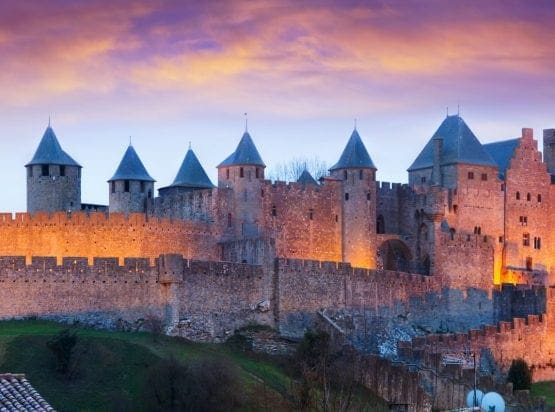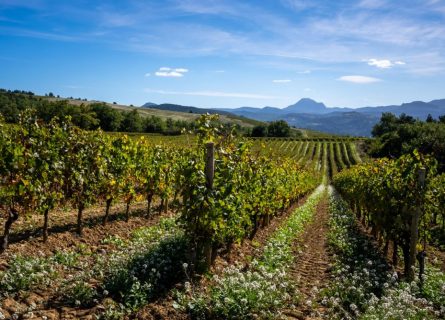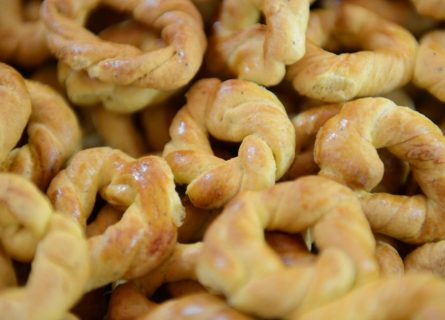Uncover Carcassonne's vibrant flavors and culinary gems with our expert guides. Plan an unforgettable trip now!
Read more
EXPLORE ALL OUR LANGUEDOC-ROUSSILLON WINE REGION GUIDE
Last updated: April 4, 2025
Once an unknown quantity in the vast landscape of the Languedoc-Roussillon, Limoux has become one of its most important producers. Serendipity has undoubtedly played its part: Limoux’s delicious sparkling wines have recently become the height of fashion as consumers increasingly demand better value from their bubblies. Yet Blanquette de Limoux (or indeed Cremant de Limoux) isn’t the only thing of interest in these undulating vineyards. Some of the region’s best Pinot Noir is now made in Limoux, not to mention oak-aged Chardonnay, Chenin Blanc, and the esoteric Mauzac. You’ll even find some good Bordeaux blends in this corner of the Languedoc: cassis-scented Cabernet Sauvignon and ripe plummy Merlot. Red, white, rosé, or sparkling – it’s all yours to enjoy.
Discover More About French Wine

It is highly ironic that the small (albeit pretty) town of Limoux finds itself at the center of a major debate within wine circles. Certain experts and wine historians believe that France’s oldest sparkling wine was made here and not in the vineyards of Champagne. It is claimed that the architects of this landmark event were the Benedictine monks of the Abbey of St-Hilaire, who produced medieval fizz using the méthode rurale (continuation of the primary fermentation in bottle) in 1531. If it’s true, it means that the Languedoc was making sparkling wine long before Dom Perignon began his journey in northern France. However, several critics, including Tom Stevenson, have strongly debunked this assertion after conducting extensive research of their own. Thus, while the story is nice and romantic, we have no conclusive evidence that sparkling wine has its origins in the south of France.
Historical Viticulture in Limoux and Carcassonne
Nonetheless, people have cultivated vines in the western hills south of Carcassonne for centuries. After the Romans invaded Gaul in the last century BC, the Languedoc became a major center of wine production in the Western Empire. In the following centuries, the Visigoths and the Moors attempted to plant their flag on Carcassonne’s battlements. However, the region eventually came under Frankish control in the 8th century. Fortunately for the residents of Carcassonne, local rulers retained power because the Merovingian and Carolingian dynasties had little interest in asserting direct authority over administrative matters. By the Middle Ages, the wines of Limoux had become a firm favorite in the taverns of southern Europe, aided in no small part by Montpellier’s substantial trading links with other Mediterranean powers. However, the Albigensian Crusade, launched in 1208 to suppress the Cathar Protestant movement, led to the Languedoc’s annexation by the French crown.
Last Great Frontier
Today, there is a great air of confidence in the vineyards of Limoux as this relatively new appellation (founded in 2003) goes from strength to strength. Attracting the attention of headline investors like Edouard Delaunay, it has become one of the last great frontiers of Old World Pinot Noir—a rival, some claim, to the wines of the Cote d’Or.

Despite popular belief, not every Languedoc vineyard enjoys a ‘frying pan’ Mediterranean climate: arid summers and blissfully mild winters. Indeed, one can quite literally feel the extent of the cooling Atlantic influence in the eastern foothills of the Pyrenees; a combination of site elevation and refreshing marine breezes make all the difference at harvest time.
These topographical advantages, now a highly sought-after commodity in the Languedoc, allow growers to produce very fruit-driven and yet elegant sparkling wines infused with ripe acidity – such an undertaking would be impossible in the warmer parts of Herault. But in the cooler climate of Limoux, attaining Burgundian levels of finesse is a realistic proposition.
Limoux’s Viticultural Landscape
The vineyards of Limoux lie about 20 kilometers south of Carcassonne, from the city center. The landscape is noticeably more lush and verdant than the rest of the Languedoc, bisected by the Aude River and its numerous tributaries flanked by dense woodland. The valley floors are covered in small rock fragments that lie over a strata of clay-limestone; its porous structure retains vital moisture during the dry summer months.
Unique Terroirs of Limoux
Today, many of Limoux’s best still and sparkling wines are made in the Terroir de la Haute-Vallée subzone. Its proximity to the Pyrenees (and high altitude) elongates the growing season in this part of the Languedoc, resulting in exceptionally fresh base wines that are perfect candidates for Cremant and Blanquette production. Meanwhile, the Terroir Oceanique is another of the region’s cooler spots due to its exposure to westerly airflows. Some of the appellation’s most Burgundian Chardonnay and Pinot Noir are made in this subregion, enhanced with some French barrique. However, in the hotter, drier conditions of the Terroir d’Autun and Terroir Mediterranean, late-ripening grape varieties like Cabernet Sauvignon and Syrah are the wiser choice.
Limoux is one of the few places in the world that still practices an ancient winemaking technique known as the méthode rurale. Producers use it to make Blanquette Méthode Ancestrale, a sparkling wine that does not undergo secondary fermentation. Instead, the winemakers transfer partially fermented juice into a bottle, completing the primary fermentation in a sealed environment. Thus, the wine achieves its effervescence by continuing the first vinification; there is no liqueur de tirage, and many bottles are sold unfiltered. The result is a lusciously sweet fizz with a low alcohol content comparable to Italy’s Asti Spumante. However, unlike Asti, Blanquette Méthode Ancestrale often contains yeasty sediment, a fermentation byproduct. It is completely harmless and indeed may be good for you!
Traditional Sparkling Wine
Nevertheless, most sparkling Limoux is made using the traditional method. Cremant and Blanquette de Limoux are made this way – the principal difference between the two styles is the grape variety. In the case of Blanquette, the indigenous Mauzac grape must account for a minimum of 90% of the blend, topped up with a small volume of Chardonnay and/or Chenin Blanc. Yet Cremant de Limoux allows a far higher percentage of Chardonnay in the vat, creating a more recognizable style of fizz for those accustomed to Champagne and its New World derivatives. However, the lemon and apple-scented Mauzaz have a more distinct character and finer acidity.
Chardonnay and Pinot Noir
Limoux’s other triumphs include superlative Chardonnay and Pinot Noir, exemplified by Domaine de la Metairie d’Alon’s Solaire. Described by the British critic Charles Metcalf as “a wine that could so easily be mistaken blind for a top premier cru Volnay,” Solaire is a product of both exceptional winemaking and exceptional terroir. After the harvest, about 75% of the berries are crushed and added to open vats along with the whole bunches – stalks and all. The rationale behind this approach is the freshness and grip that ripe stems can bring to the wine; a total de-stem may be necessary for difficult vintages, however, as unripe stalks can result in bitter flavors.
The Winemaking Process
After a brief cold soak (three to four days), the juice is fermented at relatively low temperatures (73-77°F) using a mixture of punch down and pump over to extract color, tannin, and flavor. Maturation in barrique for nine months adds complexity and textural richness, although no new oak is used as this would smother the glorious Limoux fruit. Tasted blind, this wine has ‘duped’ more experts and critics than any other Languedoc-grown Pinot Noir. It truly is in a league of its own: impeccably fresh, silky, and elegant. It is a world apart from the (admittedly excellent) Bordeaux blends made in the warmer parts of this venerable appellation.

The iconic vineyards of the Cote d’Or cannot hope to supply the world with enough high-class Pinot Noir – there is simply not enough land available, and expansion is impossible. Plus, collectors will pay almost any price for the rarest Grand Crus of the region, which means that most consumers have no hope of tasting these magical red wines. The only solution, therefore, is to look elsewhere.
A New Frontier for Burgundian Varieties
Historically, the quest for affordable and high-quality Pinot Noir was generally limited to the New World: the US West Coast, New Zealand, Chile, and the cooler parts of Australia all produce some exceptional wines from this stubbornly capricious grape. Yet, in the bucolic landscape of Limoux, an exciting revolution is transforming our perceptions of the Languedoc. To quote one of its most important investors: “As land prices in Burgundy have reached astronomical levels, producers are, of course, searching for new opportunities in emerging regions like Oregon – Limoux is also now attracting the attention of Burgundy houses, as the higher altitude, cooler vineyards are some of the most suitable in the Languedoc for growing Burgundian varieties,” said Edouard Delaunay.
The Rise of Domaine de la Metairie d’Alon
“Burgundy is too small and Burgundy producers simply don’t have enough wine. Everybody is looking for other places to grow Pinot Noir. Albert Bichot, for example, has invested in the Limoux region.”
Delaunay is the joint owner of Domaine de la Metairie d’Alon, a historic estate renowned for its supple, red fruit-scented Pinot Noir and Burgundian Chardonnay. It is located between Limoux and Roquetaillade, in the Languedoc’s Haute Vallée de l’Aude. Here, calcareous soils and high elevation work their magic on a grape that is notoriously fussy about its environment, yielding simultaneously complex and yet quite ethereal wines. Ten years ago, Domaine de la Metairie d’Alon was an outlier in Limoux, producing ‘Grand Cru’ Pinot Noirs at village prices. But as local growers expand and deepen their knowledge of Limoux’s best terroirs, more and more producers are rising to the first division. In the 20th century, Mediterranean-grown Pinot Noir was considered a mere curiosity due to the small volumes and lack of global interest. However, with the acreage expanding at an impressive rate, it could be the Languedoc’s new secret weapon.
The Sparkling Wine Boom
Meanwhile, the urge to produce exceptional sparkling wine, both Blanquette and Cremant de Limoux, is spreading like wildfire in the zone. Few labels had any traction in export markets in the 1900s due to a lack of general renown and consumer awareness. But with leading supermarkets – and restaurants – now on the hunt for premium Champagne alternatives, a once local phenomenon has morphed into an international best-seller. We predict exciting times ahead.
Chenin blanc is a white wine grape varietal from France's Loire Valley Wine Region. It's a highly versatile grape that produces delicious, light-bodied wines.
Find out moreChardonnay is a green-skinned grape varietal native to the Burgundy wine region in France and one of the most popular varieties worldwide.
Find out moreMauzac: A white grape mainly grown in Gaillac and Limoux, Languedoc-Roussillon, Southern France. Often used in sparkling wines like Crémant de Limoux.
Find out moreDiscover grenache, a mediterranean grape that is dark-skinned red wine grape variety and an unlikely hero of a grape
Find out moreDiscover the irresistible allure of Cabernet Sauvignon—a worldwide favorite with robust, dark-bodied flavor. Unleash your wine journey today!
Find out moreCabernet Franc grape is a close relative of Merlot and Cabernet Sauvignon and is the principal blending grape used in Bordeaux.
Find out moreDelve into Malbec, a dark, small grape native to France, cherished for its thick skin and exceptional flavors. 🍇🍷
Find out moreMerlot is the most cultivated grape in Bordeaux and closely related to Cabernet Franc
Find out moreSyrah is dark-skinned and perhaps the most underrated of the 'noble' red grape varieties.
Find out morePinot noir is a light-bodied red wine varietal closely related to the Vitis vinifera grape and produces the most sought-after red wines in the world.
Find out more
Limoux gastronomy is a real highlight of any visit to the region, particularly if you have a sweet tooth. Indeed, even the savory Pebradous snack (a pepper-infused fried dough ring) looks like it belongs with a digestif. To that list, you could add the Limos ( a circle of sweet brioche soaked in rum syrup and topped with dried fruits) or the exquisite nougat that lines the windows of cute little patisserie. Meanwhile, cassoulet and fresh market fish are as abundant as these sweet treats in Limoux’s family-run restaurants – many offer lunch menus that are excellent value.
A Gastronomic Guide to the Cuisine of Languedoc-Roussillon: Read more

Uncover Carcassonne's vibrant flavors and culinary gems with our expert guides. Plan an unforgettable trip now!
Read moreIf you would like us to customize an exclusive luxury tour, contact us and let us know your travel plans. We offer luxury food and wine tours for private groups of a mininium two guests. In addition, all of our private, chauffeured tours are available year-round upon request.

